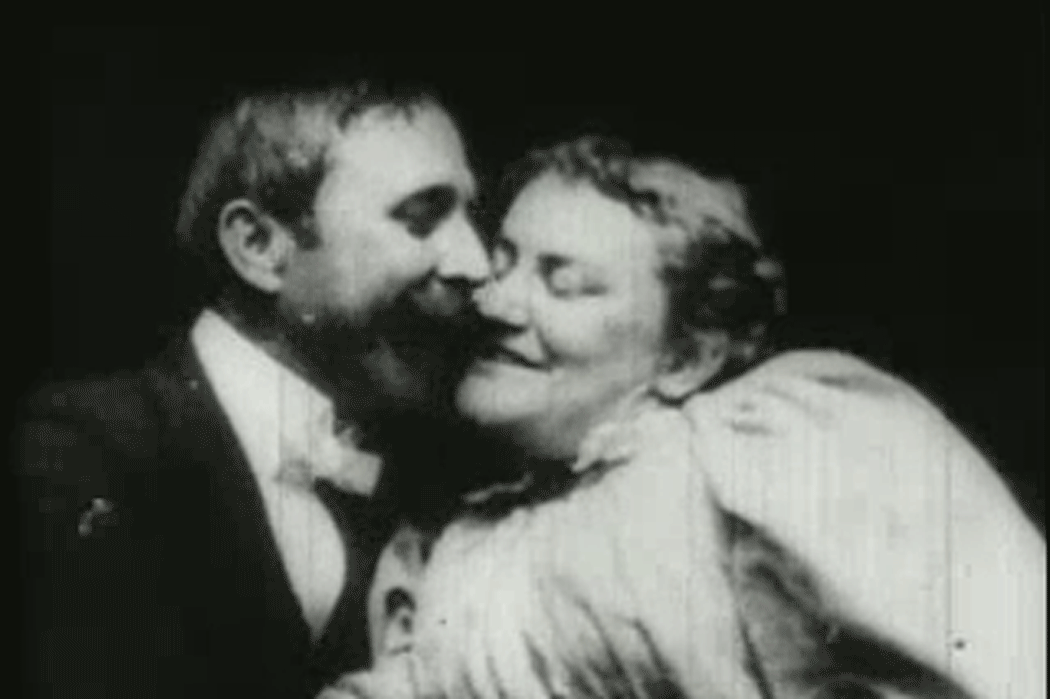The kiss between May Irwin and John Rice only lasted about two seconds, but it created an international sensation. It was the first time anyone had filmed a kiss, let alone shown it to the public, and moviegoers couldn’t get enough. Audiences crowded vaudeville theaters and music halls to see the two actors embrace on film “in a way that [brought] down the house every time,” according to a Thomas Edison, Inc. catalog.
The filmmakers behind The Kiss hadn’t put much thought into their cinematic display of affection. It was little more than a publicity stunt, which borrowed from a preexisting scene in Irwin and Rice’s successful musical comedy on Broadway. But this short film marked a thrilling shift in what movies could do, and what audiences could expect from the fledgling new medium.
The Kiss arrived in 1896, when movies were still a captivating new concept. Auguste and Louis Lumiere had just begun showing off their cinematograph—a hand-crank camera that included a projector—in demonstrations around Paris, three years after Thomas Edison had invited spectators to peer into the peephole of his kinetoscope and watch the flickering film inside. The technology was developing every day, and so were the stories. As creative pioneers like Georges Melies entered the scene, moviegoers could expect to see a lot more than simple figures in motion. New shorts debuted promising scenes of shaving, sneezing, and speeding trains. One thing that was conspicuously lacking, however, was romance.
Edison fixed that problem soon enough. The inventor had been making films out of the “Black Maria”—his production studio in West Orange, New Jersey, so named after the slang term for a police wagon—since 1893, but in 1896, he shot something a little different. That spring, he brought the two stars of The Widow Jones out to his studio to film the kiss from act one of their hit show. In the play and subsequent short film, May Irwin and John Rice begin their love scene with their cheeks pressed closely together, as they whisper out of the sides of their mouths. The comedy continues until the couple finally breaks the silly pose, smiles, and then shares a chaste peck on the lips. Edison’s short ran roughly 20 seconds, and would premiere later that year.
As UC Berkeley film professor Linda Williams writes, The Kiss immediately became “the most popular of the many shorts being shown” when it debuted. Audiences found it fresh and funny, and the media breathlessly fed into the hype. In a New York World article titled “Anatomy of a Kiss,” the newspaper reported, “For the first time in the history of the world it is possible to see what a kiss looks like… In the forty-two feet of kiss recorded by the kinetoscope every phase is shown with startling distinctness… The real kiss is a revelation. The idea of the kinetoscopic kiss has unlimited possibilities.”
Some accounts were a little cheekier. In the Los Angeles Herald, a writer mused, “I believe that a forty-two foot kiss is the record for sweetness long drawn out. I once knew a man who kissed a girl in three yards on the same day—but that’s only nine feet.” The public fascination was so intense that fans soon started demanding live reenactments. When Rice took the stage with his actress wife Sally Cohen that summer, fans yelled from the gallery, “Where’s the ‘Widow Jones’ kiss?” Cohen declined to participate in an imitation, but a young lady ran down the aisle offering to take her place.
Weekly Newsletter
The craze even spread to other countries. In 1897, The Kiss ended up in the hands of Araki Kazuichi, a “dealer in Western electrical sundries,” by film scholar Peter B. High’s account. With the use of his Vitascope, he screened the print for Japanese audiences in Osaka, where it was a blockbuster, not least of all because the kiss played in a loop. The show was nearly cut short, however, when the police showed up to catch the latest showing. The police held the power to halt any performance deemed “offensive to public morals,” but luckily for Kazuichi, his narrator Ueda Hoteikan was quick on his feet. As High writes, Hoteikan rose to introduce the film and informed the audience that “just as it was customary for old friends to greet each other with a pat on the back, Westerners typically saluted each other with a kiss.” The movie they were about to watch was thus “documentary footage” of a strange foreign culture, not a slightly titillating piece of fiction. The police remained in their seats, and the show went on.
Sweet, sensational, and slightly scandalous, The Kiss was a cinematic milestone that left audiences clamoring for more. Early filmmakers met the demand with a wave of similarly-themed shorts like The Kiss in the Tunnel and Something Good—Negro Kiss, which both premiered before the turn of the century. As the medium grew into itself, movie kisses would grow more sophisticated with crisper picture and sound, but perhaps none would remain quite as revolutionary as the playful little moment between May Irwin and John Rice.
Support JSTOR Daily! Join our new membership program on Patreon today.







